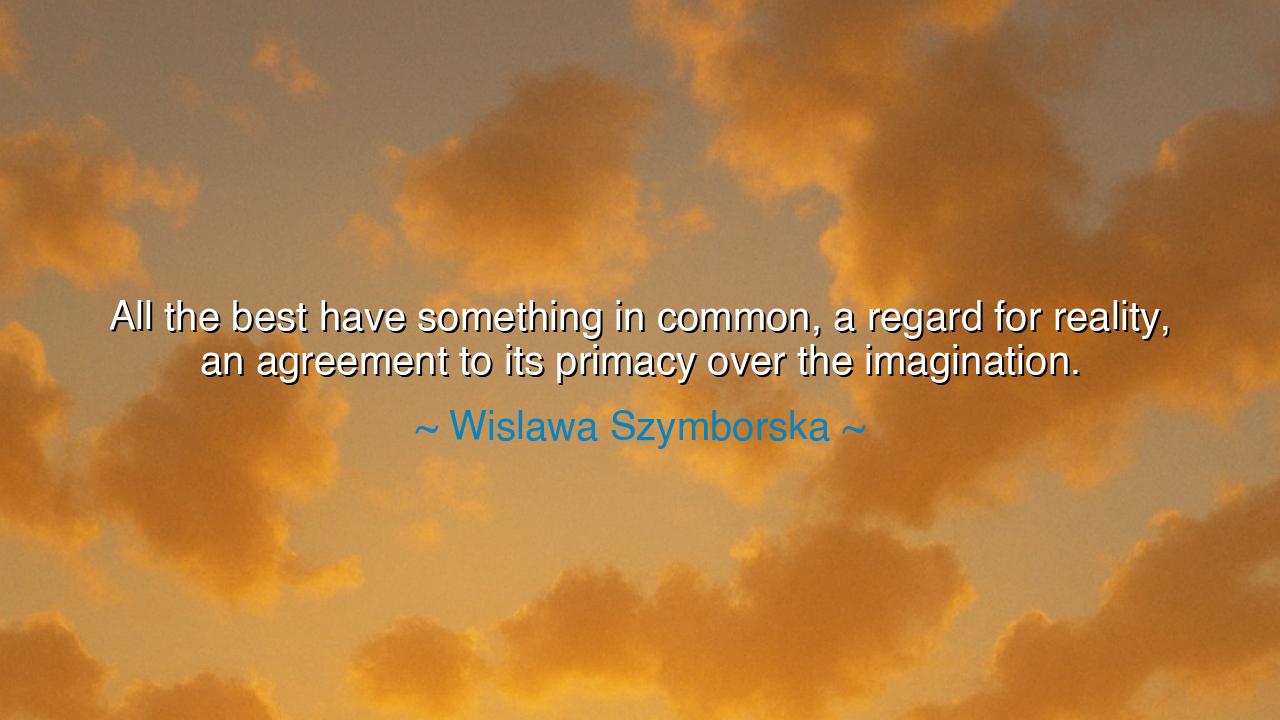
All the best have something in common, a regard for reality, an
All the best have something in common, a regard for reality, an agreement to its primacy over the imagination.






The words of Wislawa Szymborska — “All the best have something in common, a regard for reality, an agreement to its primacy over the imagination.” — are not merely an observation, but a quiet commandment for the soul that seeks truth. Szymborska, a poet of piercing clarity and deep humility, speaks here not against imagination, but of the sacred balance between dream and truth. In her wisdom, she reminds us that all greatness — whether of art, thought, or character — rests upon a regard for reality, upon a reverence for what is, before what we wish it to be. The imagination, though divine, must bend its knee before the facts of existence, or it will drift into illusion and vanity.
The origin of this quote lies in Szymborska’s lifelong meditation on the human condition. Living through the storms of the twentieth century — war, tyranny, the crumbling of ideologies — she saw how easily men and women are deceived by fantasies: political, romantic, and spiritual. She witnessed how the imagination, unmoored from truth, can become a tyrant of its own — creating false paradises that collapse into ruin. Thus, when she speaks of the “primacy of reality,” she calls us back to the earth, to the quiet discipline of seeing things as they are, not as we would have them. The truly great — the “best” — are those who build their dreams upon the solid foundation of truth, not upon the shifting sands of illusion.
In ancient times, the philosophers spoke similarly. Aristotle, in his study of poetry, declared that art must imitate life — not merely in form, but in essence. The poet, he said, should not flee from reality, but reveal its deeper patterns. In this way, Szymborska’s wisdom joins the lineage of the ancients: for her, the imagination is not the enemy of truth, but its servant. A dream without reality is fantasy; reality without imagination is despair. The finest souls unite both — but always in their rightful order, with reality as the compass and imagination as the sail.
Consider the story of Marie Curie, whose life embodies Szymborska’s teaching. Curie, too, possessed imagination — the ability to see what others could not yet see. But her vision was anchored in regard for reality. She spent endless nights in the laboratory, refining, observing, verifying. She did not invent a world of false discoveries; she wrestled patiently with truth until it revealed its secrets. In doing so, she turned imagination into discovery, and vision into law. Her greatness did not lie in escaping reality, but in loving it enough to uncover its hidden order. Such is the mark of all who endure — scientists, poets, and dreamers alike.
Szymborska’s warning carries a quiet power in our modern age, where illusions multiply faster than ever. The world is flooded with images and opinions — with false narratives masquerading as truth. It is tempting to dwell in the comfort of our own imagination, to ignore the harshness of fact and the weight of the real. Yet, as she tells us, only those who bow before reality can rise into true greatness. The imagination that refuses discipline becomes fantasy; but the imagination that embraces truth becomes creation. The former deceives, the latter transforms.
This truth is not only for artists or thinkers — it belongs to all who seek to live well. To honor reality is to accept life as it is: both its beauty and its brokenness. It is to see clearly the world around us — the pain, the injustice, the love, the miracle of existence — and still choose to engage it, not escape it. The best among us, as Szymborska says, do not hide from reality’s difficulties. They face them with courage, and use imagination not as a mask, but as a lamp — illuminating the hidden corners of what is real, giving meaning to what might otherwise seem meaningless.
Let this, then, be the lesson: cherish your imagination, but ground it in truth. Dream boldly, but never forget to awaken. Look at the world as it truly is, even when it wounds you, for only then will your dreams bear fruit that lasts. The artist must look at suffering and find beauty, not denial; the leader must look at injustice and imagine justice that can be achieved; the lover must see flaws and still choose devotion. All these require a regard for reality, for without it, imagination collapses into delusion.
And so, as the ancients would say, truth is the root and imagination the blossom. Without the root, the flower withers. Without the flower, the root lies unseen. Szymborska’s words remind us to hold both — to see the world with open eyes and to dream with open heart. For those who walk in this balance, life ceases to be a battle between what is and what could be — it becomes a harmony, a dance between reality and imagination, where truth gives birth to wonder, and wonder leads us deeper into truth.






AAdministratorAdministrator
Welcome, honored guests. Please leave a comment, we will respond soon